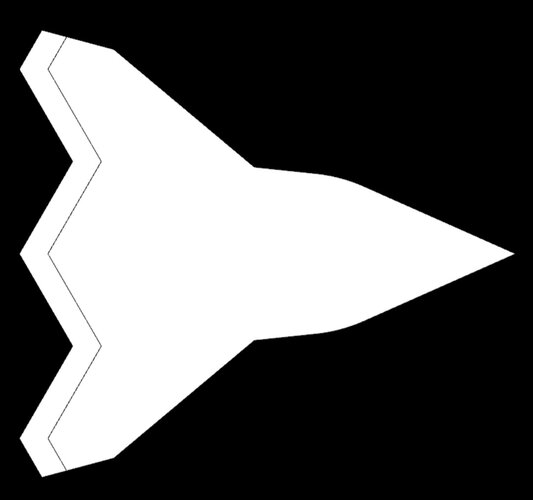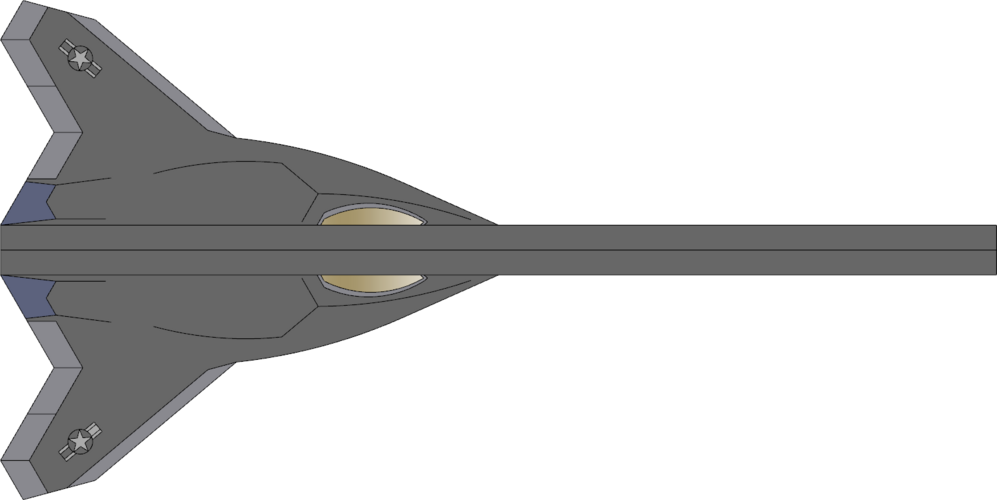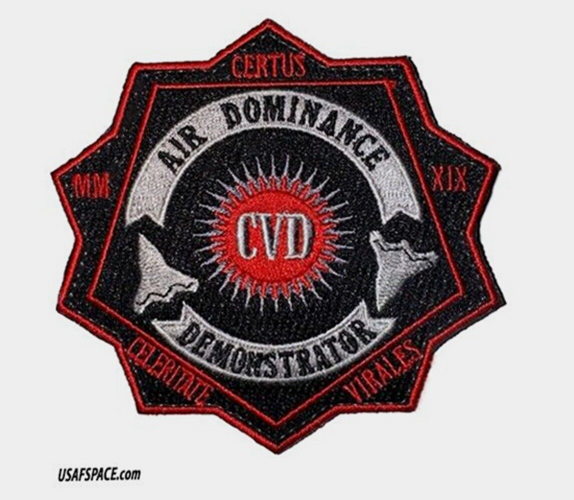Circling back to the OBSS/OBWS discussion, something I did not realize about the Gambit platform is that the engine is not actually part of the core components. GA specifically states that a more fuel efficient engine can be used for the Gambit 1 configuration. So the performance differences between the weapon station and sensor station could be quite dramatic, given not just different control surface and forward fuselage arrangements but different power installations as well. I guess with fly by wire and computer modeling, having very different engine masses and outputs is not a major problem?
You are using an out of date browser. It may not display this or other websites correctly.
You should upgrade or use an alternative browser.
You should upgrade or use an alternative browser.
USAF/US NAVY 6G Fighter Programs - F/A-XX, F-X, NGAD, PCA, ASFS news
- Thread starter Matej
- Start date
DWG
ACCESS: Top Secret
- Joined
- 11 February 2007
- Messages
- 1,910
- Reaction score
- 2,634
WRT OBSS, no one seems to have mentioned the possibility of using it for bistatic radar. OBSS as the active source, manned platforms receiving silently. At a minimum it will give you bearing and possibly range-rate. With two transmitters, or two cooperating receivers, or a transmitter with a known location, triangulation should be possible.
DWG
ACCESS: Top Secret
- Joined
- 11 February 2007
- Messages
- 1,910
- Reaction score
- 2,634
It's no different to different fuel states and throttling the engine back and forth. The major issue would be if you significantly changed the aircraft's centre of gravity, in which case it's an aerodynamics question as much as a flight-control laws one. But if the wings are as changeable as the engines then you would just need a a matched wing-engine pair.I guess with fly by wire and computer modeling, having very different engine masses and outputs is not a major problem?
It's been done before, the Eurofighter prototypes were set-up to use RB199 or EJ200 on the assumption the airframes would be ready before the engine, but then Volker Ruehe single-handedly delayed the airframe, letting the engines catch up, so in the event only DA1 and DA2 flew with RB199.
And because EJ200 was built with the same attachment points as RB199 there was some thought to putting it in Tornado.
dark sidius
ACCESS: Top Secret
- Joined
- 1 August 2008
- Messages
- 778
- Reaction score
- 479
Interesting shape...
Scott Kenny
ACCESS: Above Top Secret
- Joined
- 15 May 2023
- Messages
- 7,359
- Reaction score
- 6,930
And apparently flew in 2019? MMXIX
- Joined
- 6 August 2007
- Messages
- 3,147
- Reaction score
- 2,722
And apparently flew in 2019? MMXIX
The patch very obviously references COVID-19, the "2019" may just be another one of those references.
dark sidius
ACCESS: Top Secret
- Joined
- 1 August 2008
- Messages
- 778
- Reaction score
- 479
What to see between Covid 2019 and a NGAD demonstrator ? Nothing to see..The patch very obviously references COVID-19, the "2019" may just be another one of those references.
donnage99
ACCESS: Top Secret
- Joined
- 16 June 2008
- Messages
- 1,264
- Reaction score
- 513
the demonstrator was used to demonstrate the ability to shoot highly concentrated beam of covid-19What to see between Covid 2019 and a NGAD demonstrator ? Nothing to see..
First patch to pop up (I suppose) came from this listing I came across in January.
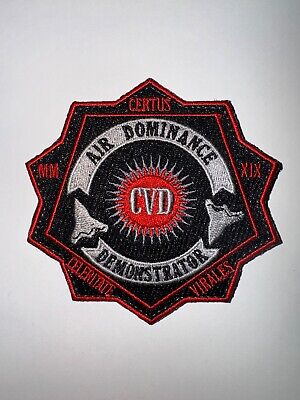
USAF Air Dominace Demonstrator Area 51 Patch | eBay
United States Air Force USAF Air dominace Demostrator Area 51 Patch.
www.ebay.com
Replicas are available here, and this is the image's source.
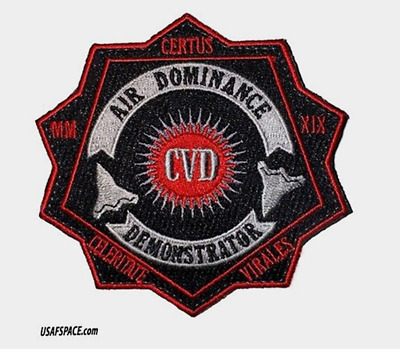
USAF AIR DOMINANCE DEMONSTRATOR NGAD-AFGSC -AREA 51- VEL PATCH | eBay
THIS - 100% EMBROIDERED - 4" - USAF PATCH on HOOK & LOOP BACKING IS IN - MINT - CONDITION. AIR FORCE PATCH on HOOK & LOOP BACKING. NASA LITHOS AND SPACE COLLECTIBLES ARE LISTED.
www.ebay.com
Scott Kenny
ACCESS: Above Top Secret
- Joined
- 15 May 2023
- Messages
- 7,359
- Reaction score
- 6,930
Explain.The patch very obviously references COVID-19, the "2019" may just be another one of those references.
DWG
ACCESS: Top Secret
- Joined
- 11 February 2007
- Messages
- 1,910
- Reaction score
- 2,634
Celeritate Certus Virales MM XIX - Fast and True Virus 2019.Explain.
Of course other viruses are available - MERS, SARS, Rubella, Suter....
DWG
ACCESS: Top Secret
- Joined
- 11 February 2007
- Messages
- 1,910
- Reaction score
- 2,634
There was actually a serious point buried in my last post. Network Attack is almost certainly one of the expected capabilities for 6th Gen aircraft and drones. The Celeritate, Certus, Virales patch could refer to such a programme. "Fast and true" isn't something we'd normally apply to a virus like Covid, but it could be applied to a Network Attack capability like Suter.Folks, let's cut this line of discussion off before it gets real dumb. Please.
dark sidius
ACCESS: Top Secret
- Joined
- 1 August 2008
- Messages
- 778
- Reaction score
- 479
Or it could mean ,with this stealth and speed abble to go in enemy territory like a virus...There was actually a serious point buried in my last post. Network Attack is almost certainly one of the expected capabilities for 6th Gen aircraft and drones. The Celeritate, Certus, Virales patch could refer to such a programme. "Fast and true" isn't something we'd normally apply to a virus like Covid, but it could be applied to a Network Attack capability like Suter.
Scott Kenny
ACCESS: Above Top Secret
- Joined
- 15 May 2023
- Messages
- 7,359
- Reaction score
- 6,930
Hard to say. I mean, AIM-260 is apparently flying, but still classified shape.With the contract being awarded this year does that mean we're expecting a demonstrator picture at least? I need more after the B-21...
There have been a couple of NGAD demonstrators flying as well, but no images published.
I do not the get the feeling like we are gto to see the new toys. If anything, the USAF is being even more secretive than I remember it being in the Cold War. You will see a UAV or an AAM when is deployed operationally, and the latter only externally.
Last edited:
Scott Kenny
ACCESS: Above Top Secret
- Joined
- 15 May 2023
- Messages
- 7,359
- Reaction score
- 6,930
Very much so. There was a lot more drawings and concept art floating around during ATF and ATB than there has been for NGAD and B21.I do not the get the feeling like we are gto to see the new toys. If anything, the USAF is being even more secretive than I remember it being in the Cold War. You will see a UAV or an AAM white is deployed operationally, and the latter only externally.
donnage99
ACCESS: Top Secret
- Joined
- 16 June 2008
- Messages
- 1,264
- Reaction score
- 513
We live in a world much more susceptible to security breaches compared to cold war thanks to globalism, specifically international supply and manufacturing chains and of course the internet. Remember how Boeing was found to have subcontractors downloading loads of classified tech in foreign lands and fed to china or the enormous breach on the f-35 data?
- Joined
- 1 April 2006
- Messages
- 10,889
- Reaction score
- 7,502
That's not true actually. If you are talking of _concepts_ from OEMs. And you saw an official B-21 rendering years before rollout, not months like with B-2.Very much so. There was a lot more drawings and concept art floating around during ATF and ATB than there has been for NGAD and B21.
Never underestimate the complexity of an unmanned aircraft. It has to do all the things a manned aircraft of similar capabilities must do...with a very complex set of data links spliced in.Well I imagine a UAV just has less systems to go wrong from a maintenance point of view. And I bet a commercial engine outlasts the aircraft by thousands of hours. And depending on how complex your UCAV is (I’m a fan of smaller and simpler), maybe there’s no radar to go wrong either. And if it’s really hard to repair: tear off the the wings and engine and anything else fairly easily removed and just trash the thing. If it a Williams 44 engine, that’s probably almost half the cost anyway. Don’t do maintenance; do rapid manufacturing.
dark sidius
ACCESS: Top Secret
- Joined
- 1 August 2008
- Messages
- 778
- Reaction score
- 479
It don't do the same things , it is unable to conduct interception , or sky policy or doing supersonic flight it is not the same than a piloted aircraft.Never underestimate the complexity of an unmanned aircraft. It has to do all the things a manned aircraft of similar capabilities must do...with a very complex set of data links spliced in.
Scott Kenny
ACCESS: Above Top Secret
- Joined
- 15 May 2023
- Messages
- 7,359
- Reaction score
- 6,930
Yet an MQ-9 Reaper (just the airframe, not counting the control station) is roughly twice the price of a PC-12NG (~$4.5mil)... Go figure.It don't do the same things , it is unable to conduct interception , or sky policy or doing supersonic flight it is not the same than a piloted aircraft.
FlyGuy369
Flying is fantastic
- Joined
- 15 June 2023
- Messages
- 77
- Reaction score
- 167
While we are on the topic of technology being introduced into these upcoming platforms, an interesting thing caught my eye about the patch that I've seen in abstract is the use of biomorph pulsator jets for the use of reducing turbulent airflow and increasing laminar performance, and it just so happens that the images traceline on the aft of the aircraft is reminiscent of those abstract patent images
Attachments
jsport
what do you know about surfing Major? you're from-
- Joined
- 27 July 2011
- Messages
- 6,719
- Reaction score
- 4,181
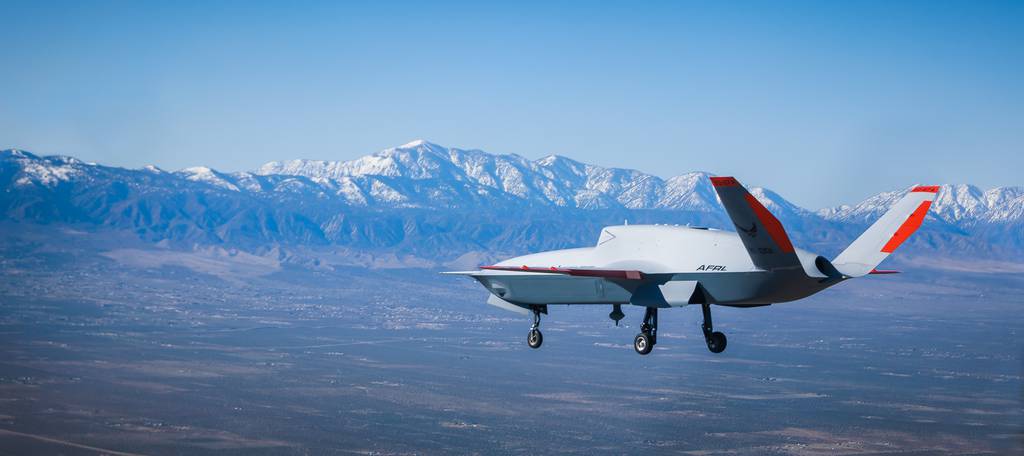
Carmaker model may yield cheaper drone wingmen: Air Force Research Lab
AFRL hopes building drones on a common chassis structure, the way the auto industry builds cars, will let it turn out aircraft cheaper and more quickly.
WatcherZero
ACCESS: Top Secret
- Joined
- 22 May 2023
- Messages
- 551
- Reaction score
- 1,052
2025 budget request cuts planned $1.5bn funding for F/A-XX next year by 2/3rds and delays the project schedule a year.
Air Force on the other hand is prioritising R&D over airframes with cuts in procurement in many aircraft programs, more aircraft retirements but an increase in NGAD funding by $815m, $166m boost for CCA and $116m for operational experimentation of unmanned systems by an evaluation unit. B-21 R&D is being slowed slightly with a $300m cut but an increase of $400m for airframe production.
Rear Adm. Ben Reynolds, the deputy assistant secretary of the Navy for budget, said that was one of the “hard choices” resulting from the limited top line. The delay also gives industry more time to mature technology, he added, saying the Navy is “still committed” to this piece of its Next-Generation Air Dominance family of systems.
Air Force on the other hand is prioritising R&D over airframes with cuts in procurement in many aircraft programs, more aircraft retirements but an increase in NGAD funding by $815m, $166m boost for CCA and $116m for operational experimentation of unmanned systems by an evaluation unit. B-21 R&D is being slowed slightly with a $300m cut but an increase of $400m for airframe production.
LRS-B was awarded to NG in 2015 and there was an artist concept unveiled in 2016. Hopefully we see something according to that schedule.
Unless it already has been unveiled? The general outer mold lines of the real NGAD may have been hidden in all the artist concepts that have been released.
Unless it already has been unveiled? The general outer mold lines of the real NGAD may have been hidden in all the artist concepts that have been released.
dark sidius
ACCESS: Top Secret
- Joined
- 1 August 2008
- Messages
- 778
- Reaction score
- 479
Navy will fall realy behind the USAF and it is no time to slow down with the Russia and China, navy do a bad mistake to delay FA/XX2025 budget request cuts planned $1.5bn funding for F/A-XX next year by 2/3rds and delays the project schedule a year.
Air Force on the other hand is prioritising R&D over airframes with cuts in procurement in many aircraft programs, more aircraft retirements but an increase in NGAD funding by $815m, $166m boost for CCA and $116m for operational experimentation of unmanned systems by an evaluation unit. B-21 R&D is being slowed slightly with a $300m cut but an increase of $400m for airframe production.
If its not needed why a 'mistake' ?
dark sidius
ACCESS: Top Secret
- Joined
- 1 August 2008
- Messages
- 778
- Reaction score
- 479
Not needed ? with the war in Ukraine ? it is time to show the toys , Super Hornet are old , F-35 c not in number to face China it is not the good fleet.If its not needed why a 'mistake' ?
Navy will fall realy behind the USAF and it is no time to slow down with the Russia and China, navy do a bad mistake to delay FA/XX
The truth is that FA-XX probably is a lot less significant than NGAD. The odds of USN aviation being offensively decisive are very low, and F-35/F-18 provides adequate defensive firepower. I also get the impression from this cut and the official statement that FA-XX is not as far along as NGAD and/or the USN would rather let the USAF absorb more of the risks and costs of the associated technology.
dark sidius
ACCESS: Top Secret
- Joined
- 1 August 2008
- Messages
- 778
- Reaction score
- 479
I agree USAF do the job very well , B-21 in time , NGAD contract this year .....The truth is that FA-XX probably is a lot less significant than NGAD. The odds of USN aviation being offensively decisive are very low, and F-35/F-18 provides adequate defensive firepower. I also get the impression from this cut and the official statement that FA-XX is not as far along as NGAD and/or the USN would rather let the USAF absorb more of the risks and costs of the associated technology.
I agree USAF do the job very well , B-21 in time , NGAD contract this year .....
Well my point was more that carrier strikes were never going to deliver decisive results anyway - tactical aircraft are going to be a lot more limited in the volume of fire they can deliver than land based bombers supported by long range fighters. To some extent, the USN can "cheat" against naval targets, substituting MALD-N for actual cruise missiles to increase the apparent strike size, but ultimately the contribution of a few embarked air wings is not going to be as decisive as land based air.
joewee
ACCESS: Restricted
- Joined
- 9 March 2021
- Messages
- 34
- Reaction score
- 88
So what are USN carriers for if holding targets-at-risk is better done by long-range aircraft, missiles, or submarines? Is the defacto purpose of carrier aircraft to defend the floating bases?Well my point was more that carrier strikes were never going to deliver decisive results anyway - tactical aircraft are going to be a lot more limited in the volume of fire they can deliver than land based bombers supported by long range fighters. To some extent, the USN can "cheat" against naval targets, substituting MALD-N for actual cruise missiles to increase the apparent strike size, but ultimately the contribution of a few embarked air wings is not going to be as decisive as land based air.
Seems the outcome of an objective and comprehensive DoD-wide cost/benefit analysis (fat chance) would find that there are better choices than sustaining 11 carrier strike groups for the primary missions of showing the flag or attacking third-world belligerents.
So what are USN carriers for if holding targets-at-risk is better done by long-range aircraft, missiles, or submarines? Is the defacto purpose of carrier aircraft to defend the floating bases?
Seems the outcome of an objective and comprehensive DoD-wide cost/benefit analysis (fat chance) would find that there are better choices than sustaining 11 carrier strike groups for the primary missions of showing the flag or attacking third-world belligerents.
My argument is not the carriers are useless; my argument is that FA-XX probably will have less impact that NGAD in a PRC-US conflict. Not only will the number in theater always be rather small, but also the USN is largely building its offensive anti ship capability around stand off weapons that would not necessarily require long range counter air. This is because surface combatants represent very high density AD targets where the air defenses are co-located with the target on very flat terrain compared to land based targets. As such, direct attack munitions are not really a workable solution (hence the proliferation of various flavors of AShMs).
In terms of cost benefit analysis in a peer conflict, one would probably have to factor not just the effectiveness of the platform but also how much of the PLAN, PLARF, and the PRC orbital infrastructure resources are spent on anti carrier efforts as a result.
Heh. This is actually close to being correct.better choices than sustaining 11 carrier strike groups for the primary missions of showing the flag or attacking third-world belligerents
Military strong-arm tactics dont work out well these days when proliferation of fifth collumnists, sympathizers and long-range transports and heavy construction equipments means that offending leaders can simply run and hide in a luxurious cave somewhere in god-know-stan before their minions murder enough troops that the "defendant" have to pull back because of anti-war activist. It worked out quite well for the Taliban, after all. The PRC demonstrated that the smart ones, worthy of help, will bite the money. And illiterate tribal-class god-know-stan-ers can have their own concubines and sheeps, not giving a darn to whatever cultural, economic and technological revolution there is. Don't try to force-feed them with foreign ideas that highly contrasted with their historical cultural values. Guess what happened to women's rights in Afghanistan? I think one of the main pusher for the Mujahideens were that the new socialist government tried to implement reforms that wouldve stripped the tribe leaders of most of their powers and prestiges.
And I don't think that "showing the flag" needs 11 supercarriers for all that matters. The Brits seems pretty content with their blue-water OPVs doing that job. Some of the "through-deck"/aviation cruiser/hybrid capital ships could probably do that job well. Drones and specops would do quick work of the less competent third world military dictatorships and the actual supercarriers could be doing roles that wouldn't need so many deployments, and hence, less refits and maintenance cycles.
Re F/A-XX, I'd agree that delaying the program is a rational choice. It's far more important that the USN gets what it needs right now (state-of-the-art IAMD system, new SM-6/3 rounds on faster schedule, FFG-62s and Flight IIIs, plus the first Columbia-class, and many tinier acquisitions/efforts). Plus the F-35C is adequate as it is, why bother spending money waiting for new shinier, but paper stuff?
Colonial-Marine
UAVs are now friend, drones are the real enemy.
- Joined
- 5 October 2009
- Messages
- 1,254
- Reaction score
- 842
I am once again given the impression that NAVAIR doesn't know what it wants and doesn't know what it's doing. There is no point in having such a force of modern CVNs if the aircraft on them aren't kept to date to match the latest threats. There seems to be a focus on strikes against PRC mainland targets if it came to war but what about the role of protecting the surface fleet itself? The threat isn't just those anti-ship ballistic missiles that seem to get all of the focus.
Similar threads
-
-
CNO Greenert Warns Congress of Fighter Shortfall, Hornet Line to Close 2017
- Started by Triton
- Replies: 1
-
Boeing Begins Production of F/A-18E/F Distributed Targeting System
- Started by seruriermarshal
- Replies: 0
-
Lockheed Martin F-35 Lightning II Joint Strike Fighter (JSF)
- Started by Triton
- Replies: 5K
-

